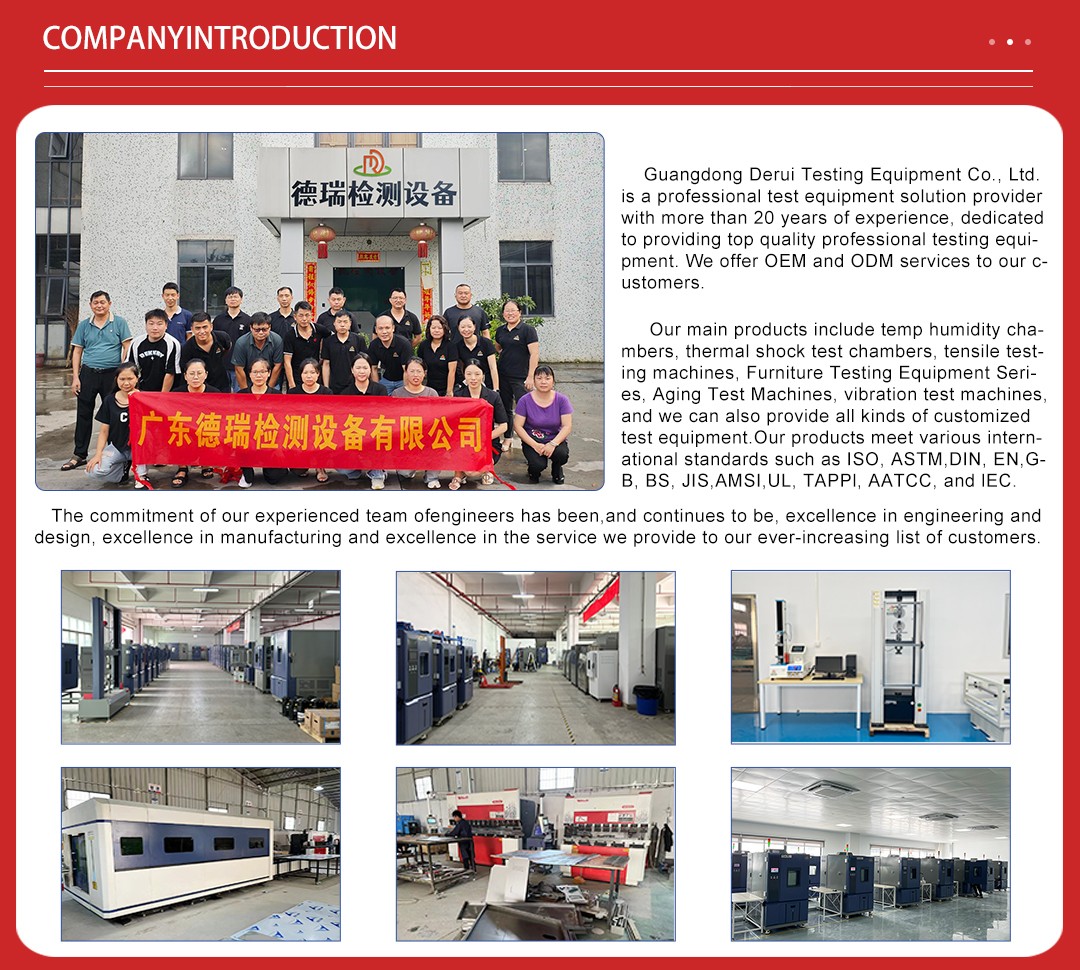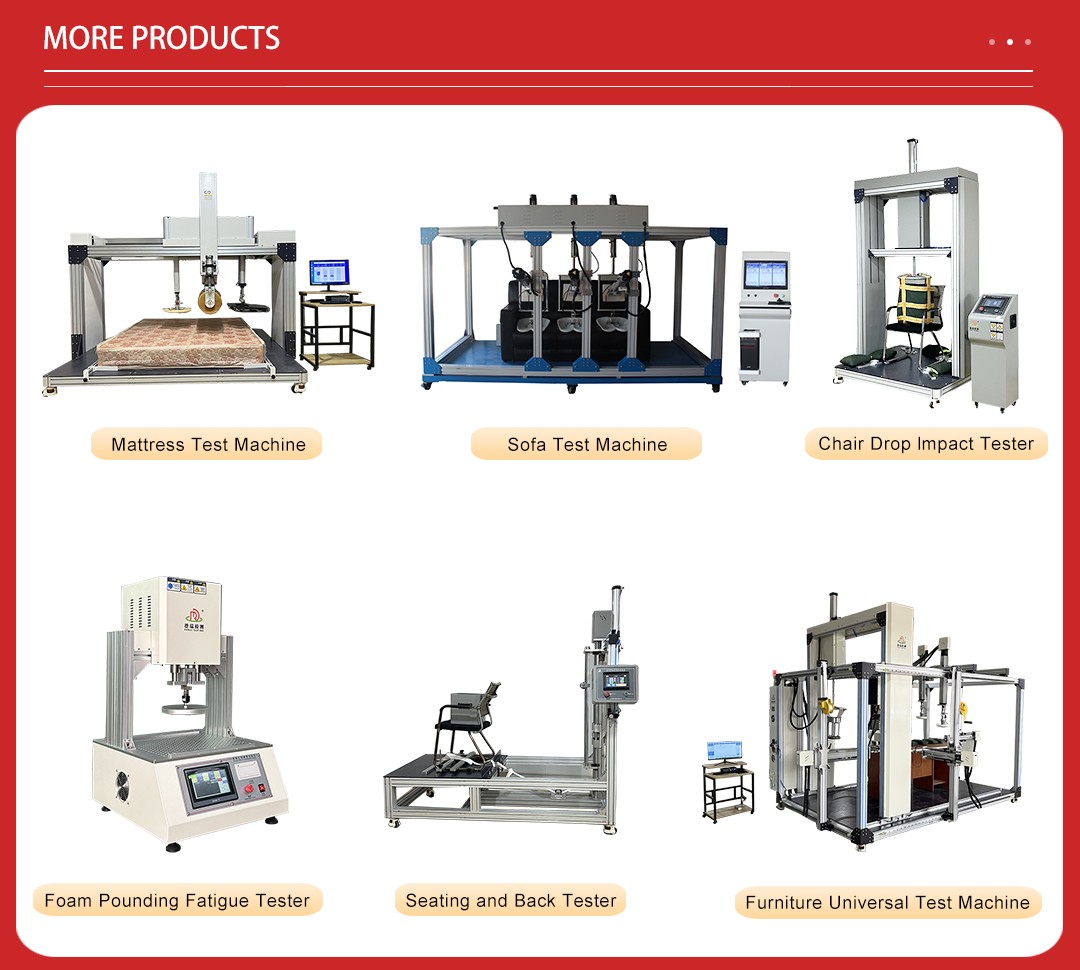
Furniture Comprehensive Testing Equipment is simulated in everyday conditions , inspection rocking chair bearing durability . The test will be a certain shape , quality of load modules , placed on the ...

The Furniture Comprehensive Testing Equipment is designed to emulate real-world scenarios, specifically for assessing the endurance of rocking chairs under load. This process involves subjecting the chair to a cyclical stress test, where a predetermined form and mass of load modules are positioned on the seating surface and the backrest. The chair is then subjected to a series of repetitive push-and-pull motions to simulate the rocking action. This regimen continues until a specified number of cycles have been completed, thereby evaluating the chair's bearing capacity under fatigue conditions. Such rigorous testing is instrumental in refining the product mix, identifying and mitigating potential quality issues, and ultimately enhancing the longevity and dependability of the furniture.

According to EN 1335-3,EN 581 2,EN 1728, BIFMA X5.1,can do chair bending durability test,According to EN 527-3 and EN 581-3,can do desk vertical and horizontal test, 5 action operator,it can do test automatically.
Sample:Chair,swivel chair,armchair,stool,rocking chair,desk.

Swing amplitude 300 ~ 500mm
Calculator 0 ~ 999 , 999 times ( adjustable
Weights 10KG ( of 15 )
Maximum counterweight weight 150KG
Dimensions ( approx . ) ( L * W * H ) 1650 * 1300 * 2150mm
Power 3 ∮ , AC380V , 50Hz
En1728 , GB1728 , Bifma × 5 . 5
Chair back strength durability test
Chair leg strength test - forward / lateral loading
Pedals ( ring ) static load test - Vertical
Pedals ( ring ) endurance test
Handrails durability test equipment

1. Seat Static Load Test: Apply a vertical force at the designated loading point for a minimum of 10 seconds, then repeat this procedure 10 times to assess the seat's resistance to static loads.
2. Seat Surface Fatigue Test: Utilize a loading pad to apply a 950N vertical force on the seat surface at a rate not exceeding 40 cycles per minute, simulating the fatigue endured by the seat surface under regular use.
3. Seat Surface Impact Test: Place a foam cushion on the seat surface and subject it to impacts from a predetermined height, allowing it to free-fall and strike the loading area 10 times to evaluate impact resistance.
Seat Back Test Methods:
1. Seat Back Static Load Test: Secure the chair or stool's feet and apply a predetermined load perpendicular to the seat back at the loading point, maintaining the force for at least 10 seconds and repeating the process 10 times.
2. Seat Back Fatigue Test: With the chair or stool feet secured, apply a 950N vertical force on the seat surface mount points and a 330N force on the back mount point for a prescribed number of cycles, at a rate not exceeding 40 cycles per minute.
Impact Test for Seat Surface: As described in the seat surface impact test, use a foam cushion and simulate impacts from a set height to assess the seat's resilience to shock loads.
1. Backrest Static Strength Test (Load Function): Apply an 890N load for one minute without causing structural failure.
2. Backrest Static Test (Standard Load): Apply a 1334N load for one minute, ensuring the main structure remains intact.
Office Chair Compression Testing:
3. Ipomoea Static Test: Apply a 11120N force for one minute without causing structural failure; repeat the process without oil contact on the test platform.
4. Dynamic Impact Test (Function Load): Simulate a 4102KG body weight dropping from 6 inches height onto the seat center, ensuring no major structural changes occur.
5. Dynamic Impact Test (Standard Load): Simulate a 136KG body weight dropping from 6 inches height onto the seat center, ensuring no major structural changes occur.
6. Rotating Test: Perform 60,000 rotations at 360-degree intervals with a 102KG load, assessing durability at both the highest and lowest points of the chair.
7. Tilt Mechanism Fatigue Test: Apply a 102KG load at a 10-30 cycles per minute rate for 300,000 cycles without structural fatigue.
8. Shock Test: Simulate a 357KG load dropping from 1 inch height onto the seat 100,000 times without causing significant durability loss.
9. Seat Forefoot Fatigue Test: Apply a 734N load on each seat rake for 20,000 cycles without causing durability loss.
10. Backward Stability Test: Apply a 79KG load to the center of the seat until the weight transfers to the back support, ensuring the tipping force is less than 89N.
11. Forward Stability Test: Block chair casters with a 13MM barrier and apply a 600N force at the leading edge of the seat from 60MM height, ensuring the seat can withstand 20N of force without tilting.
12. Armrest Vertical Static Strength Test (Function Load): Apply an 890N vertical load at the weakest point for one minute without causing durability loss.
13. Armrest Vertical Static Strength Test (Standard Load): Apply a 1334N vertical load at the weakest point for one minute without causing major structural changes.
14. Armrest Level Static Strength Test (Function Load): Apply a 445N horizontal load at the most forward point of the armrest for one minute without causing durability loss.
15. Armrest Level Static Strength Test (Standard Load): Apply a 667N horizontal load at the most forward point of the armrest for one minute without causing major structural changes.
16. Back Fatigue Test: Apply a 102KG load at the seat center and a 445N vertical urging force for 120,000 cycles without fatigue wear.
17. Castors Fatigue Test: Apply a 102KG load and cycle across hard surfaces with obstacles and soft surfaces without fatigue wear for 2000 and 98000 cycles, respectively. After a 22N thrust cycle test, casters should remain intact.
18. Armrest Fatigue Test: Apply a 400N force at a 10-degree angle for 60,000 cycles on each armrest without causing structural damage or fatigue wear.

